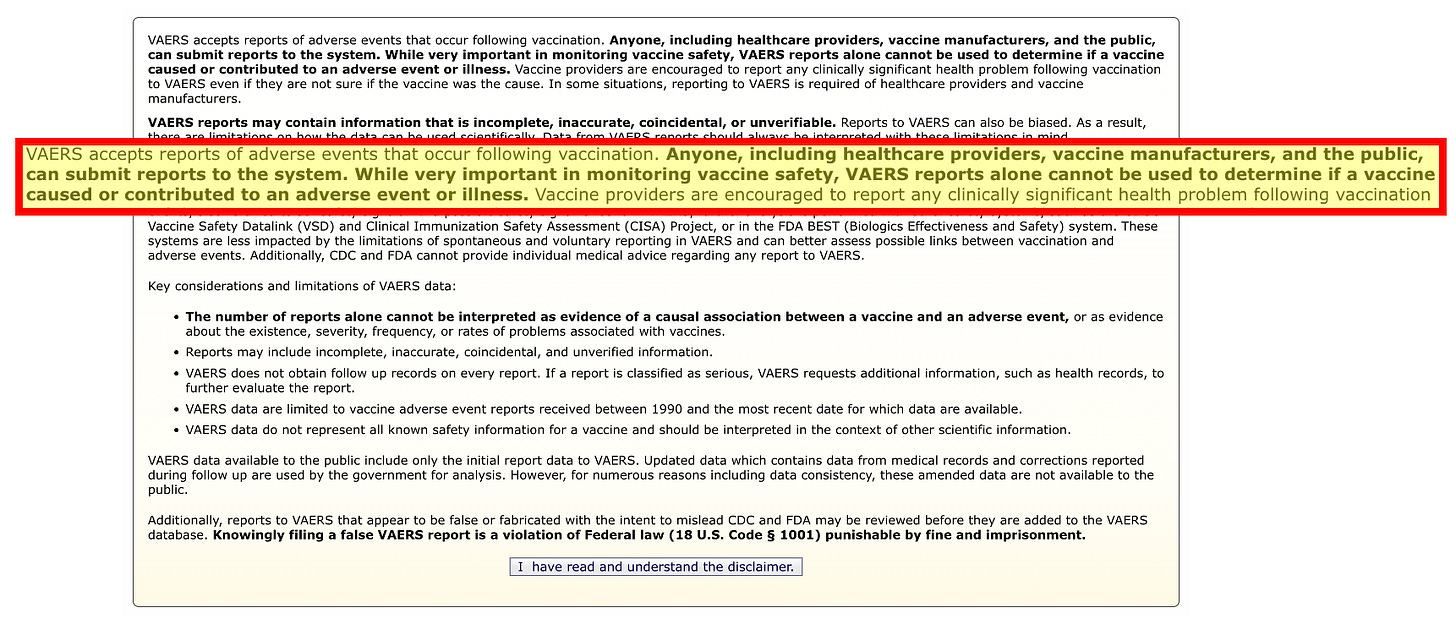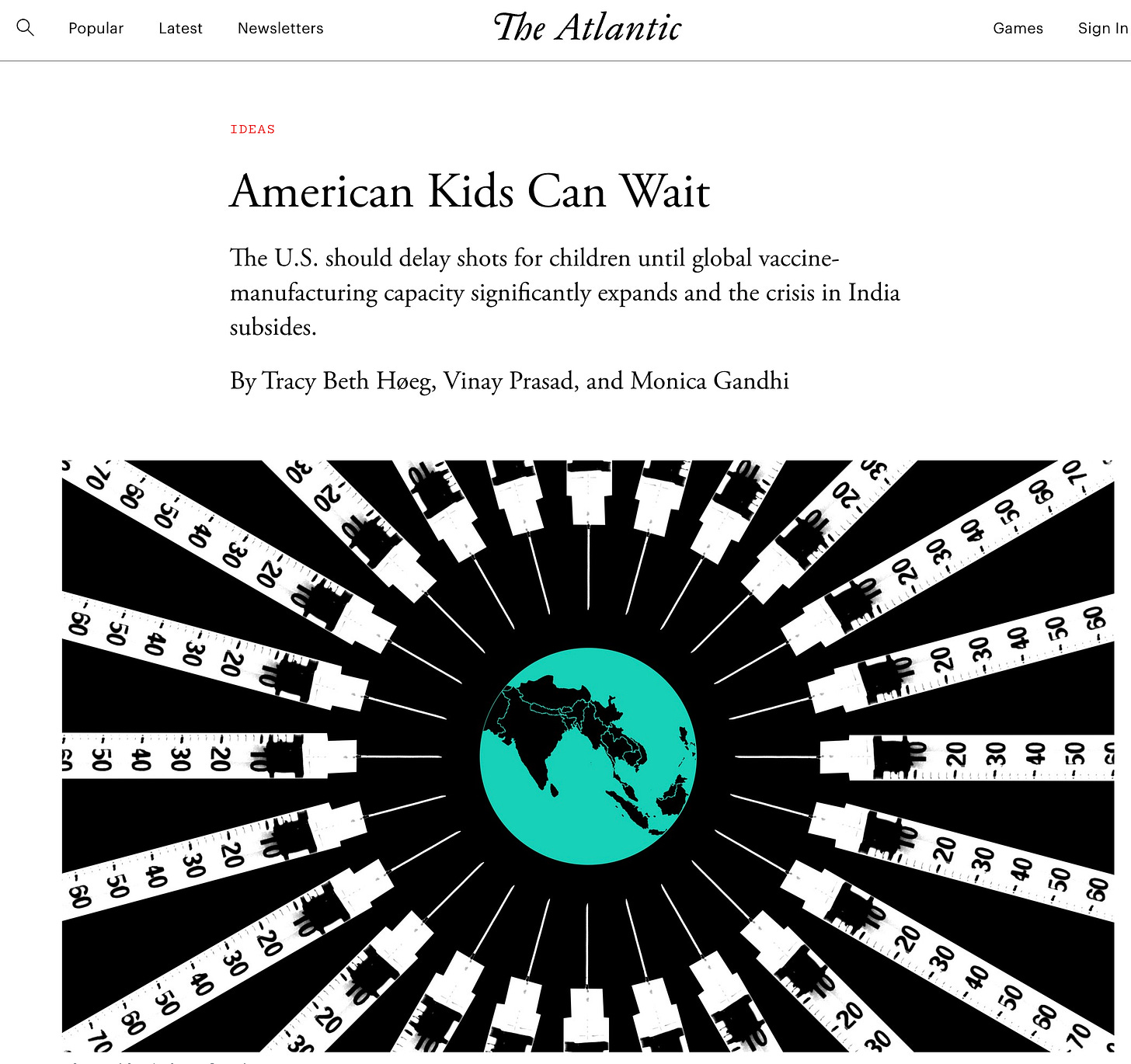VAERS: What It Is, Why It Matters, and What You Must Understand before Thursday
And why the CDC needs to rename it
News reports indicate that, when the CDC Advisory Committee on Immunization Practice (ACIP) meets this Thursday and Friday, they will be hearing about a study suggesting that the COVID vaccine kills children. The data come from the Vaccine Adverse Event Reporting System (VAERS), which sounds like the perfect place to look for a list of adverse events caused by vaccines. In fact, it is explicitly not intended for that, and this study should be ignored. Here’s why.
What the Hell is VAERS
What is VAERS? VAERS is what epidemiologists call a passive reporting system. That means the public health organization simply records events reported by others. It does not make any systematic effort to proactively collect data. Some call it coffee cup epidemiology. Others do the work while you sip coffee and wait for something to happen. Passive surveillance is not uncommon. Reportable infectious disease databases are passive reporting systems. They rely on health professionals to report any cases of specific infectious diseases known to pose a risk for disease outbreaks or track COVID. If a cluster occurs, CDC sends a team to investigate.
Two things make VAERS distinctive. The first is that reporting is not limited to health professionals. ANYONE can file a report with VAERS. The second and most unique aspect is that VAERS involves prior assessment of a causal relationship. The person reporting simply must believe that the vaccine could possibly be related to the health outcome.
BUT. There is absolutely NO WAY to objectively associate any adverse health outcome with a vaccine. This bears repeating. The only evidence of a causal relationship between the vaccine and the effect in the VAERS database is timing. The adverse event happened at some time after vaccination. This is intentional. The goal was to capture any possibility of an event, so the net is cast as widely as possible. The real epidemiology doesn’t begin until the data in VAERS suggest something unusual is happening.
So, VAERS was designed with an abundance of caution. Its creators did not want to miss anything. It was never intended to study causal relationships. The website explicitly warns users not to do that, stating, “The CDC explicitly warns on its VAERS website that reported adverse events “cannot be interpreted as evidence of a causal association between a vaccine and an adverse event”. It even requires them to acknowledge this to enter the site.
So VAERS was misnamed. It is not a database of adverse events caused by vaccines as the name implies. It needs rebranding. A more accurate name would be the Database of Adverse Events Reported After Vaccination?
How Often Would We Expect Sudden Death to Occur After Vaccination Just By Chance?
An example should make this clear. Adverse health events are constantly happening to people of all ages, with or without vaccines. The most extreme of these is sudden death, an event that is far more common in adults, but does happen in children. There are two categories of sudden death in children, sudden unexplained death in childhood (SUDC) or sudden cardiac death (SCD). By definition, the immediate cause of these events is often unknown. If it occurred shortly after vaccination, it would be entirely reasonable to report it to VAERS.
Now, let’s do some math. Every year about 20 out of every million children die of either SUDC or SCD. That means, on average, a child has about an 0.8 in a million chance of sudden death in any given two-week period. Children have received about 30 million total doses of the COVID vaccine. So, in the two weeks following those doses, we would expect 30 times 0.8 or about 24 childhood deaths BY CHANCE ALONE. I would expect most if not all to be reported to VAERS. Unfortunately, a report of 24 deaths of children related to the COVID vaccine, if it were not presented with proper caveats, would not be seen as a chance event. It would immediately be read by a huge swath of the public as clear evidence that the vaccine is killing children.
If we did see many more than 24 sudden childhood deaths in the VAERS data, the proper response would be to do a separate epidemiological study of this relationship. Even without that finding, appropriate epidemiological studies using original data have been done and have found no significant increase in childhood mortality related to COVID vaccines.
Tracy Beth Hoeg and the New Study
The New York Times and The Washington Post have both reported that Tracy Beth Hoeg, a Sports Medicine Doctor with no background in pediatrics or immunology will be reporting to ACIP on deaths in children using data from VAERS. Hoeg made a name for herself during the pandemic by opposing public health measures from testing, to school closures, to childhood COVID vaccines. Her most widely read paper was a deeply flawed risk benefit assessment that concluded the COVID booster does more harm than good in young men, published, oddly enough, in The Journal of Medical Ethics. Her co-author on that paper was her current boss, FDA Administrator, Marty Makary.
Hoeg is one of the few people in the NIH leadership with a PhD in epidemiology. Even though her research focus before COVID was on eye diseases, as an epidemiologist, she should know better than to use VAERS to conduct studies of causal epidemiology. In any case, she apparently has done a study of childhood deaths related to the COVID vaccine using the SARS data. How many vaccine related deaths did she find? According to the Washington Post, it’s not 24. It’s 25.
So, expect another circus from ACIP this week. And be prepared to critique this study when the anti-vax community seizes on it. And, when rational leadership finally returns to HHS, we should change the name of VAERS.




